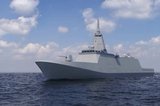Royal Navy locates US sonar lost at sea
The UK Royal Navy’s Sandown class minehunter HMS Bangor has used its Thales 2093 Variable Depth Sonar to locate a US Navy AQS-24 towed sonar when it became detached from a MH-53 Sea Dragon helicopter during an exercise.
The successful detection of the towed sonar saved more than $1 million for the US Navy. The crew of Bangor were taking part in a major Anglo-French-US minehunting exercise in the Gulf when the incident occurred.
Following its detection by the 2093, the sonar was then retreived by a US dive team using its Seabotix underwater robot.
The 2093 sonar is a variable-depth, multi-mode minehunting sonar. It can detect and classify very small objects on the seabed and in the water. As part of the Sonar 2093 Capability Sustainment Programme, the Royal Navy is set to receive wideband capability, which will further enhance the performance of this sonar system.
Phil Jones, head of Thales UK’s maritime business, said: ‘This is a fantastic example of what our minehunting sonars can achieve today. The current performance of Sonar 2093 is outstanding, but I’m sure the Royal Navy will be delighted with the improvements they will receive through the Capability Sustainment Programme. I’m glad that the US Navy was able to get its towed sonar back. A real team effort.’
Related Equipment in Defence Insight
More from Naval Warfare
-
![US Navy to acquire micro-uncrewed underwater vehicles for ISR and coastal data collection]()
US Navy to acquire micro-uncrewed underwater vehicles for ISR and coastal data collection
The Naval Supply Systems Command is seeking authorised resellers of JaiaBot uncrewed underwater vehicles and multivehicle pods. The platforms will support undergraduate education at the US Naval Academy.
-
![US Navy advances with the Harpoon Service Life Extension Programme]()
US Navy advances with the Harpoon Service Life Extension Programme
The US Navy plans to improve Harpoon’s anti-ship and land attack capabilities by equipping the missiles with sensors and technologies required for succeeding in future battlespace.
-
![Mitsubishi eyes future with Australia’s Mogami selection]()
Mitsubishi eyes future with Australia’s Mogami selection
With Australia’s selection of the Mogami-class for Project Sea 3000, Mitsubishi is investigating local production in the next decade as potential export opportunities emerge.






















